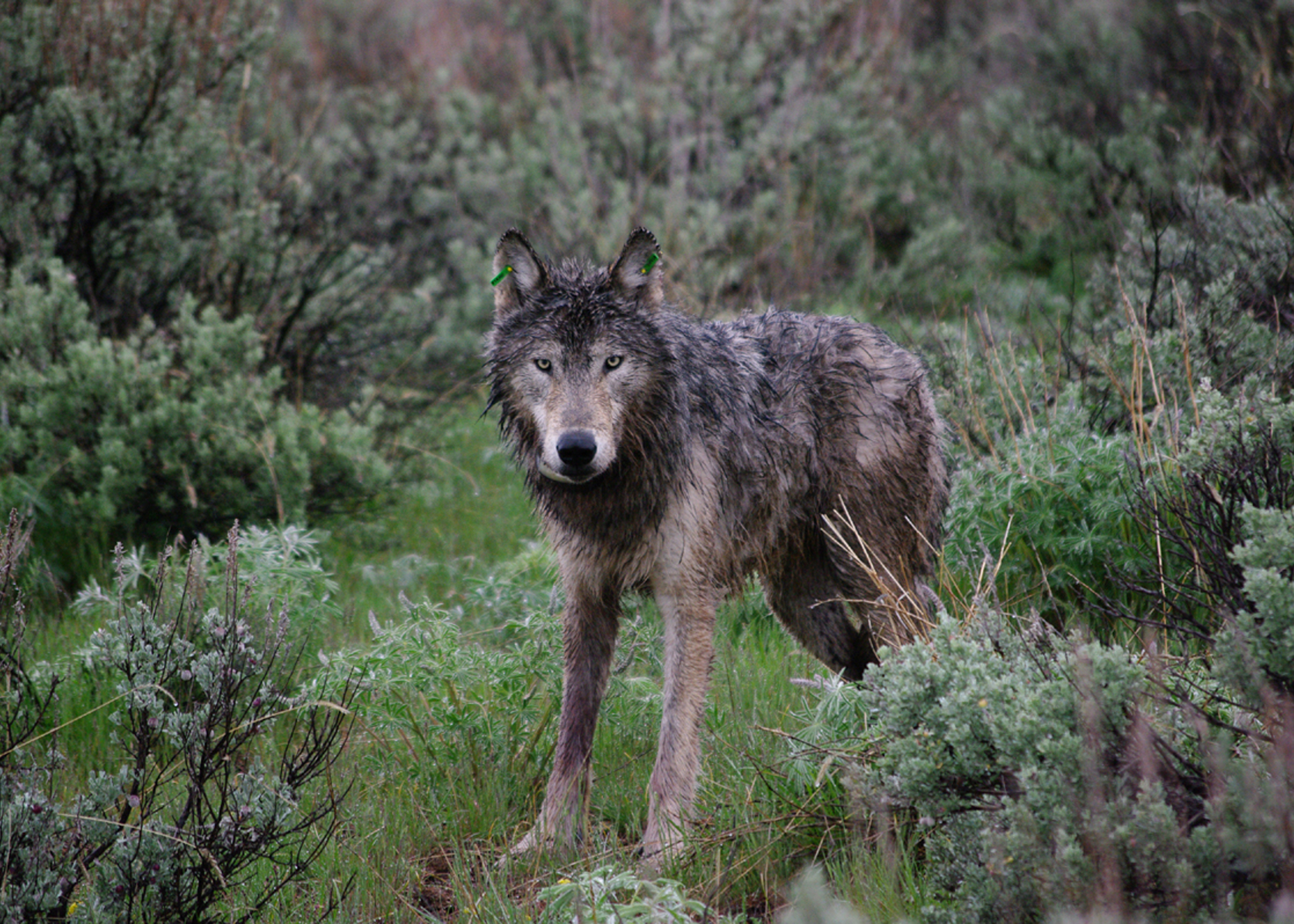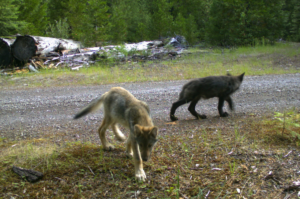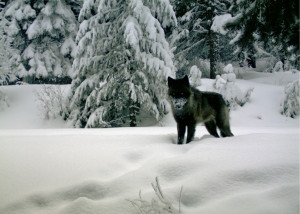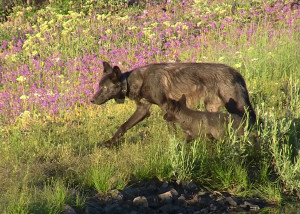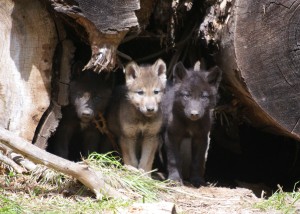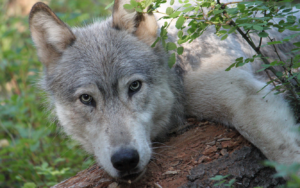*Area of Known Wolf Activity (AKWA) is designated by ODFW showing where wolves and/or packs have been documented repeatedly over a period of time.
2022
September 6, 2022: Due to several depredations by OR-103, who is protected as an endangered species under the Federal Endangered Species Act because he is in western Oregon, ODFW has established a Conflict Deterrence Plan to assist livestock owners to non-lethally manage potential conflict with wolves.
August 12, 2022: There is a new AKWA in Klamath County. OR-103, an adult male, had spent time in California before returning to Oregon in July of this year.
August 10, 2022: Oregon State Police are investigating yet another wolf who has been illegally shot. OR-112 was a two year old female from the Keating Pack. It is estimated that she was shot around August 4th near Halfway, Oregon. There is an $11,500 reward leading to arrest of conviction of those responsible. She is the fourth illegally killed wolf this year.
July 21, 2022: There is evidence of a new wolf pack in the Deschutes/Klamath Counties area.
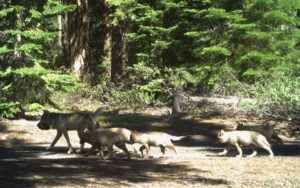
Potential new pack in Deschutes/Klamath county area. (photo by ODFW, 2022)
A trail camera caught an adult with five pups on the move. It is unclear at this point if it’s a new pack or if they are part of the Indigo Pack.
June 17, 2022: ODFW has issued another kill order for four additional wolves from the Chesnimus Pack. Despite efforts by the livestock producer to utilize non-lethal deterrents, they continue to see depredation by the pack. Kill orders are for a specific period of time and for a specific number of wolves. This order lasts through July 17th. Further details are found on this ODFW page listed by date.
June 13, 2022: Another yearling male from the Chesnimnus Pack has been killed by ODFW. This ends the current kill order issued in late April.
May 3, 2022: A yearling male from the Chesnimnus Pack was killed in response to a kill order issued by ODFW for repeat depredation by the pack.
April 19, 2022: The annual wolf management report for 2021 has been released by ODFW. It reports a minimum count of 175 wolves, an increase of two wolves over the previous year’s count. There are 21 packs documented, with 16 of those packs being breeding pairs. Additionally, eight groups of two or three wolves were identified. Wolves expanded into four new areas of known wolf activity in Grant, Jefferson, Klamath and Union Counties. The majority of wolves remain in the far NE corner of the state. There are four packs west of Hwys 97/ 395 and two other areas of wolf activity that do not constitute a pack. One area includes a wolf from the Lassen Pack in northern California who is traveling with another wolf.
At the end of 2021, 16 packs were documented as successful breeding pairs, including the Rogue Pack who had five pups who survived the winter. There were 26 wolf deaths documented in 2021 (up from 10 in 2020) of which 21 were human-caused which included vehicle strikes, eight wolves killed by illegal poisoning, and eight wolves from the Lookout Mtn. Pack killed by ODFW for chronic depredation.
The full 2021 Oregon Wolf Conservation and Management Report can be viewed here.
April 2022: OR-117, a one year old male, is reported to have been killed in mid-March near the town of Richland in NE Oregon. There is an $11,550 reward for information leading to arrest or conviction of those responsible. This is the third illegal killing of wolves in 2022.
February 2022: A year after being delisted, a federal district court has re-instated Endangered Species protections for gray wolves. This includes wolves in Oregon, but does not include wolves in the Greater Yellowstone ecosystem.
OR-109 is found shot south of Cove, Oregon
January 8, 2022: OR-106, a two-year old female, who had dispersed from the Chesnimnus Pack was found shot to death about six miles SE of Wallowa, Oregon.
A $16,500 reward if offered for information leading to an arrest or conviction in the illegal killing.
2021
November 2021: After a most epic journey of nearly 1,000 miles that took him from Northern Oregon to southern California, OR-93 was found dead after having been hit by a vehicle about 75 miles NW of Los Angeles. This moving tribute to his epic journey was written by Susan Orlean.
August 2021: Two more wolves from the Lookout Mt. Pack, both 3 1/2 months old, were gunned down by helicopter by ODFW.
Pups this age are dependent on adult members of the pack for food as they are not yet able to hunt, thus not presenting a threat to livestock.
July 2021: ODFW approves a kill order for up to four wolves from the Lookout Mt. Pack after four depredations in a 14 day period
May 24, 2021: OR-93’s collar has stopped emitting signals. He was last noted to be in San Luis Obispo County, California.
May 12, 2021: OR-103 is the latest wolf to set foot in California. He was outfitted with a GPS collar on May 4 in Deschutes County, though there is not a wolf pack in that area, so he is believed to have been in the process of dispersing from an unknown pack.
May 2021: An ODFW update on the Rogue Pack can be found here.
April 2021: The annual state Wolf Management report has been released by ODFW. It reports 173 wolves in the state, which is only a 9.5% increase over the previous year. There are 22 packs, with 17 of those packs qualifying as breeding pairs. In addition, seven groups of two or three wolves were identified. The vast majority of the state’s wolf population remain in NE Oregon. There are two packs west of the Cascades, and 8 other wolves documented that do not constitute a pack. There were nine wolf deaths during the year of which seven were human-caused and four wolves were illegally shot. No wolves were killed in response to chronic depredation and one wolf was shot while in the act of chasing livestock.
The full 2020 Oregon Wolf Conservation and Management Report can be viewed here.
A consolidated version of the report can be found here.
The Rogue Wolves are no longer considered a pack, with no pups documented at the end of last year. The territory of the Rogue Wolves is shown here.
OR-93 is now in Monterey County, California.
March 2021: OR-93 has traveled through Modoc, Alpine, Mono, Tuolumne, Mariposa, Merced, Madera, and Fresno counties in California!
February 2021: OR-93, a young male from the White River Pack near Mt. Hood, has dispersed from his pack and headed south and is now in California.
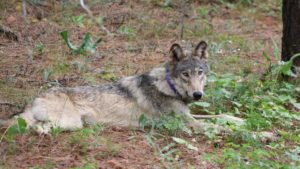
Remote camera photo of OR-93 near Yosemite taken in February 2021 (photo by California Department of Fish and Wildlife)
This is the furthest south a wolf has been known to travel in over a hundred years. He is the 16th wolf documented to have dispersed from Oregon into California starting with the arrival of OR-7 into California in December 2011.
A pair of wolves, one of whom is OR-85 from the Mt. Emily Pack, have been seen on a trail camera in northern California. OR-85 crossed into Modoc County in northern California in November 2021.
January 2021: The U.S. Fish and Wildlife Service (USFWS) has removed most gray wolves from the Endangered Species List, so management is now overseen by each state fish and wildlife agency, in this case ODFW.
Since delisting, under state management rules, livestock producers can now shoot wolves caught in the act of attacking their livestock. Numerous environmental groups, including Cascadia Wildlands, file suit following this ruling.
2020
November 3, 2020: Less than a month later, a second wolf has been poached in the same vicinity of the previous poaching in late September. She was a sub-adult of approximately 1.5 years of age and was found in the Pine Creek Pack territory.
October 29, 2020: The Trump administration has delisted gray wolves from the Endangered Species Act. This removes federal protections for gray wolves in the western part of Oregon. There are currently legal challenges in process to this delisting action. The implications of this delisting include federal money no longer being available for non-lethal deterrents or wolf biologists, poachings unable to be federally prosecuted and the statute of limitations is an even shorter period of time in which to prosecute poachers. In addition, ODFW’s Wolf Management Plan was put in place assuming federal protections for the wolves in the western part of the state.
October 15, 2020: The breeding male of the Cornucopia Pack has been killed on the Wallowa-Whitman National Forest in eastern Baker County. He had dispersed from the Walla Walla Pack and he and his mate had three pups for the first time in 2019. This poaching incident occurred on or around September 24th and is currently under investigation. As a result of the killing, survival of the rest of the female and three pups is tenuous this winter.
September 16, 2020: There is a new AKWA map for the Rogue Pack.
In 2019, the Rogue Pack was monitored throughout the year, no evidence of reproduction was observed. Approximately 11-year-old OR7, the breeding male of the Rogue Pack, was not confirmed during the winter count, though his mate was still present in the pack area with three wolves.
August 2020: Video from CDFW confirms eight pups, six of them black (as were the wolves of the Shasta Pack).
July 2020: The Lassen Pack in northern California originated from wolves from the Rogue Pack in Oregon. The original breeding male was one of OR-7’s pups who came to California in 2011. The Lassen Pack is the second confirmed pack in California in almost 100 years and this year has at least 8 new pups. The pack now totals 14 individuals: the breeding pair, 4 sub-adults from previous litters and the new pups.
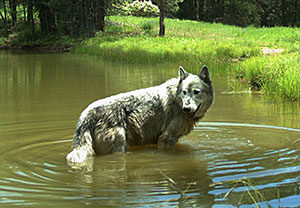
OR-30 cooling off in a pond in the Wenaha Pack area, captured on a remote camera on U.S. Forest Service land in northern Wallowa County in June, 2019 (photo by ODFW).
April 2020: The annual Wolf Report has been released by ODFW. It reports 158 wolves in Oregon , which is a 15% increase over the previous year. There are 22 packs and 19 breeding pairs. Depredations have dramatically decreased, and have not increased at the same rate as the wolf population. There were no wolf removals (kills) by ODFW and no livestock producer loss claims for last year. A synopsis is here. The full 2019 Oregon Wolf Conservation and Management Report can be viewed here.
Also of note is that OR-7 has not been seen on remote trail cameras since fall of 2019 and it is unclear whether or not he is still living. He is presumed dead. He was 11 years old, which is quite old for a wolf in the wild.
February 2020: ODFW updates 19 AKWA maps (Catherine, Chesnimnus, Desolation, Five Points, Heppner, Indigo, Lookout Mt, Middle Fork, Mt. Emily, Noregaard, OR60, OR76 (Bear Creek), Pine Creek, Rogue, Ruckel Ridge, Silver Lake, South Snake, Wenaha, Wildcat), and 4 new AKWA maps designated (Cornucopia, Fivemile, OR63 Wolves, OR75). ODFW is currently conducting the annual winter count. Additional information will be available in April.
February 2020: Daughter of OR-7, well-traveled wolf OR-54, is found dead in California. She had traveled 8,712 miles across three states in search of a mate.
2019
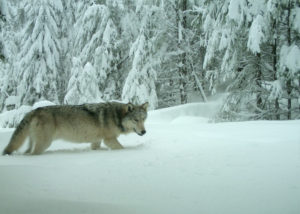
Remote camera photograph of wolf from the Indigo group on Feb. 20, 2019 in the Umpqua National Forest (photo by US Fish and Wildlife Service).
October 2019: New wolf pack documented in western Oregon. They have been named the Indigo Pack.
September 2019: Light sentence given to person who killed endangered wolf in 2016.
August 5, 2019: New wolf activity is reported in the Blue Mountain area.
July 2, 2019: A new area of known wolf activity (AKWA) has been designated by ODFW in the central portion of the Northside Unit (Grant County). Two wolves were confirmed to be using the area in June. Monitoring is ongoing to learn more about these wolves.
June 7, 2019: Nine years overdue, the ODFW adopts a revised state Wolf Management Plan.
May 15, 2019: Director of Oregon Department of Fish & Wildlife comes out in support of the federal government’s move to delist gray wolves in the U.S.
May 2019: Gov. Kate Brown signs bill that bans use of predator control devices known as M44 cyanide bombs.
April 2019: ODFW released its draft proposed Wolf Conservation and Management Plan. State wildlife biologists have determined that there are 137 wolves in Oregon. A full report can be viewed here.
April 2019: ODFW has updated maps of areas of known wolf activity (AKWA) for the Chesnimnus Pack, Grouse Flats Pack, Keating Wolves, Middle Fork Pack, OR64, Silver Lake Wolf, South Snake Pack and Shamrock Pack.
March 21, 2019: ODFW confirms that wolves have returned to Lane & Douglas counties via trail cameras (see above image). They are being called the Indigo wolves (they do not constitute a pack). The public has reported wolf activity in this area for several years. Images of the Indigo wolves are released by USFWS.
March 6, 2019: U.S. Interior Secretary announces plans to delist gray wolves in the U.S.
February 12, 2019: On Friday Feb. 8, 2019 at the Commission meeting in Portland, Chair Finley announces that the adoption of a revised Wolf Plan scheduled for March 15 would be postponed to a future meeting, to allow everyone more time to review the Plan and Commissioners more time to talk with constituents. ODFW staff intend to make a draft Plan available for review in early March; the Plan will be posted on ODFW’s wolf webpage.
February 5, 2019: Creative wolf deterrent for Rogue Pack in southern Oregon used by rancher.
February 1, 2019: One of Mount Hood wolves found dead near Hwy 36.
2018
February 27, 2018: After spending two months in California, OR-54 is back in Oregon with the Rogue Pack.
February 2, 2018: OR-54, one of the offspring of infamous wolf OR-7, crossed the border on or around January 24th, into California. She was collared by ODFW in October 2017 to track the location of the Rogue Pack. She is a two year old, at dispersing age.
February 1, 2018: Oral arguments were heard with the Oregon Court of Appeals which will decide whether Oregon state lawmakers improperly removed gray wolves from the state endangered species act. Oregon Department of Fish and Wildlife moved to delist wolves in fall of 2015. The Oregon state legislature ratified this into law in February of 2016.
January 31, 2018: A trapper admitted to trapping and killing a wolf caught in a leg hold trap. The wolf was a female born in April 2017 believed to be from the Mt. Emily Management Unit. He now faces charges.
A Washington man was recently charged and fined for killing two wolves in NE Washington.
January 19, 2018: The Commission had planned to adopt a revised Wolf Plan at the Astoria meeting in April. Today they decided to conduct some additional facilitated outreach and postpone final plan adoption in hopes of getting more consensus from stakeholders. ODFW will announce a new meeting date once that is decided.
January 16, 2018: At least two wolves are using an area in southern Wasco County, marking the first time multiple wolves have been confirmed in the northern portion of Oregon’s Cascade Mountains since they began returning to Oregon in the 2000s. The wolves were documented on the White River Wildlife Area and Mt. Hood National Forest and have also been observed on the Warm Springs Indian Reservation.
Wolves in Wasco County and anywhere west of Hwys 395-78-95 are protected by the federal Endangered Species Act, so U.S. Fish and Wildlife Service is the lead management agency.
Additional information about Oregon’s wolf population will be available later in the spring, after ODFW completes its annual winter surveys and minimum population count.
2017
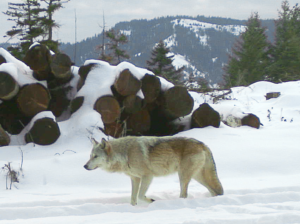
The breeding female of the Walla Walla Pack captured on a remote camera on private property in northern Umatilla County (photo by ODFW, Dec. 2017).
December 8, 2017: ODFW staff presented a working copy of the Draft Updated Wolf Conservation and Management Plan, showing the edits staff have made to the Plan since April 2017 as a result of comments from stakeholders, the public and commissioners. A panel of representatives from Wolf Program stakeholder groups also testified about the latest Plan. The Commission decided more time was needed to work on the Plan and opted to delay adoption, so they will not be considering it at their next meeting on Jan. 19, 2018 in Salem. Rule making and adoption of an updated Wolf Plan will take place at the April 20 in Astoria. Public testimony can still be submitted via email previous to the April meeting at odfw.commission@state.or.us and the public will also be allowed to testify in person at the April meeting.
December 1, 2017: The draft working plan of the state Wolf Conservation and Management Plan has been released today.
November 17, 2017: In an unprecedented series of shootings of wolves, yet another wolf has been found shot to death, this time in Wallowa County. OR-23 was a female who had dispersed from the Umatilla pack in Nov. 2014. She was part of the Shamrock Pack.
November 6, 2017: OR-25 has been found dead in Klamath County. This is the third wolf killed this year illegally. His journey started in March 2015 when he dispersed from the Imnaha Pack, traveled through the southern Blue Mountains, the Columbia Basin, the north and central Cascades and finally Klamath County. In Dec. 2015, he even made is way into California and returned to Oregon. He became one half of what was called the Keno Pair. This is the third wolf killed this year illegally.
November 2, 2017: A hunter who claims that a wolf charged him shot and killed the animal in the Starkey Wildlife Management Area in NE Oregon. She was a female and had been traveling with OR-30. There have been no charges filed.
October 23, 2017: A beautiful and thought-provoking piece written by Rob Klavins of Oregon Wild.
October 16, 2017: OR-54, a daughter of OR-7 from the Rogue Pack, has been collared by USFW. It is believed that the Rogue Pack now numbers nine wolves.
October 12, 2017: It is confirmed that a decomposed carcass found on the Fremont-Winema Forest is that of OR-33. He was illegally shot sometime this past spring. He was a three-year old male who had dispersed from the Imnaha Pack in late 2015. His journey had taken him from NE Oregon into the Borge, south into the Ochoco Mtns., east of Prineville, through the Fort Rock Valley and continuing south on the east side of the Cascades.
August 25, 2017: ODFW has killed a fourth wolf in the Harl Butte Pack, a non-breeding female. They now believe the pack to number six adults and at least three pups.
August 23, 2017: Both the Harl Butte Pack and the Meecham Pack in NE Oregon have been involved in livestock depredations and ODFW is undertaking lethal take of some pack members in both instances. To date, ODFW has killed three wolves from the Harl Butte Pack. More detailed information can be found here.
July 6, 2017: OR-7 is officially a grandfather! California Department of Fish and Wildlife (CDFW) trapped and collared a 75 pound female gray wolf. It was evident that she had pups this past spring. A trail cam in the area caught the two adults and three pups on camera. Genetic data acquired through scat testing on the Lassen Pack in northern California reveals that the male of the pair is from the Rogue Pack (OR-7 and his mate).
June 2017: Echo, a gray wolf who made an epic 500-mile journey in search of a mate, became the first wolf to visit the Grand Canyon in 70 years. In less than a few months she was gunned down by a hunter whose crime went unpunished. A lawsuit by conservation ally, WildEarth Guardians challenged and overturned the Government’s nearly 20-year-old McKittrick Policy, which required authorities to prove a hunter knew s/he was shooting an animal protected by the Endangered Species Act before being prosecuted. Now, when hunters shoot first and ask questions later the government can prosecute them if they kill endangered species.
June 8, 2017: ODFW Commission meets to discuss Wolf Plan. They discuss a variety of policy issues related to the Draft Wolf Plan. The Commission asks staff to explore adopting different standards for lethal control consideration when depredations are on public vs private land. There is no set a date for final adoption of a Wolf Plan.
May 26, 2017: OR-7 caught on trail camera carrying food in his mouth. He is now 8 years old.
May 24, 2017: Interesting interview with Brenda Peterson, writer and wildlife advocate, called “Back From the Brink: ‘Wolf Nation’.
May 23, 2017: OR42 found dead in Wallowa County. It is probable she was the breeding female of the Chesnimnus Pack.
May 19, 2017: Oregon ranchers ask for local authority to determine wolf kills.
April 2017: ODFW releases 2016 Wolf Annual Report and Draft Revised Wolf Management Plan.
April 21, 2017: ODFW holds its public hearing on the proposed changes to the Wolf Management Plan.
April 10, 2017: Wolves who are occupying territory previously occupied by the Imnaha Pack have been officially named the Harl Butte Pack. A radio collar was put on a male in that pack in February .
2016
November 2, 2016: California Department of Fish & Wildllife has confirmed the presence of two gray wolves in Lassen County. DNA samples confirm that the male is a two-year old who dispersed from the Rogue Pack. The female is not genetically related to wolves from Oregon, which is great news for the gene pool and genetic diversity.
October 2016:
Livestock depredation documented in southern Oregon. It is suspected to be the Rogue Pack but cannot be confirmed as none of them are radio-collared.
October 2016: OR-28, a 3 year old female who had dispersed from the Mt. Emily Pack made her way to southern Oregon, finding OR-3, an 8 year old male from the original Imnaha Pack. OR-28 was found shot/poached near Summer Lake area. OR-3 is now solely responsible for the survival of the young pup through this coming winter. OR-28 is the first poaching case this year. In 2015, there were 5 cases. There have been 10 wolves poached in Oregon since 2007.
August 4, 2016: OR-33 continues to inhabit the areas of SE Jackson and SW Klamath counties. This is the same area inhabited by the Keno pair. OR33 is still traveling solo, so it is likely he’ll head to another area in search of a mate.
July 28, 2016: Summer pup surveys done by ODFW and USFWS have shown at least two pups for the Rogue Pack caught on trail cameras (see photo above, right).
In addition, it has been revealed that OR-28, a three year old female who dispersed from the Mt. Emily Pack has paired up with OR-3, an eight year old male from the Imnaha Pack in 2011. It is believed they produced one pup this year.
July 21 , 2016: Since January 2016, two wolves have been photographed occasionally in the area previously used by the Umatilla River Pack. In late June, reproduction was confirmed via remote camera photographs of two pups. The AKWA map shows the area typically used by wolves north of the Umatilla River where they are confined by geographic features and established neighboring wolf packs. Biologists will continue monitoring activities to learn more about these wolves.
July 21, 2016: In early March 2016, four wolves were found within the traditional Imnaha Pack wintering area. A 10-month-old pup was radio-collared and released. That wolf dispersed from the area in mid-April. DNA analysis showed that the wolf was not related to any Imnaha Pack wolves, likely indicating that a new group of wolves were using the area. What is now believed to be the entire Imnaha Pack was removed in late March 2016 in response to chronic depredation. As of July, resident wolf activity has been documented again in the area. Biologists will continue monitoring activities to learn more about these wolves.
July 6, 2016: Oregon Court of Appeals allows lawsuit against ODFW to go forward.
June 28, 2016: Since May 2016, radio-collar locations show OR-30 primarily using a large area in the Starkey and Ukiah Units that he also frequented in summer 2015. He also infrequently visits the Mt Emily Unit and is believed to be alone.
June 22, 2016: OR-33 sighted by numerous people near Ashland.
June 2016: Updated scat analysis on the Shasta Pack in California reveals that both the breeding male and female were born into the Imnaha Pack in NE Oregon. The pack also consists of one female and three male pups.
May 2, 2016: Cascadia Wildlands files an ethics complaint to the Oregon Government Ethics Commission alleging false statements and misrepresentations by state legislators which led to the passage of HB4040. This bill legislatively removes gray wolves from the state endangered species list.
May 2, 2016: OR-33 is tracked by USFWS to be near La Pine in central Oregon. He dispersed from the Imnaha Pack in November 2015 and has since traveled though 13 counties in Oregon.
April 26, 2016: OR-37, an adult male, was radio collared in January 2016. He crossed the Snake River to Idaho within 3 weeks, and later returned to Oregon at the end of March. He has since used the area shown on the AKWA map and appears to be alone.
April 12, 2016: Guest editorial by scientist, Adrian Treves, in Eugene Register-Guard that criticizes ODFW delisting decision.
April 5, 2016: OR-7, whose radio collar died in 2015, is seen on a trail camera for the first time since last year in a remote area of Rogue-Siskiyou National Forest.
April 1, 2016: OR-29 and OR-36 have been traveling together since February, 2016. OR-29 is a radio-collared male that dispersed from the Meacham pack in December 2015. OR-36 is a radio-collared female collared in the neighboring South Snake pack, who appears to have dispersed also.
March 31, 2016: ODFW guns down four members of the Imnaha Pack for livestock depredation: OR-4, the alpha male of the pack and the father of OR-7 (Journey), OR-39, the likely pregnant alpha female of the pack, along with two of their yearling offspring. Four members of the pack remain. OR-4 was instrumental in wolf recovery in Oregon. He and his original mate, OR-2, created what became known as the Imnaha pack back in 2008. Since then he has fathered countless pups, all of whom inherited his strong, tenacious and vibrant genes.
A beautiful eulogy for OR-4.
One more eulogy.
Another remembrance of this magnificent wolf.
Article about killing of Imnaha pack in relation to state wolf plan.
Another commentary.
March 2016: Oregon State Police continue to investigate wolf poaching cases from 2015. [OR-34 was shot in Sept. 2015 and OR-31 was shot in December 2015]
March 2016: Gov. Kate Brown signs HB4040 making the ODFW delisting decision a state law and preventing the lawsuit brought against ODFW from proceeding. Guest editorial in response published in the Eugene Register-Guard.
February 29, 2016: Annual ODFW Wolf Report for 2015 released today shows 110 known wolves in the state comprised of 12 packs, four pairs of wolves traveling together and four individual wolves. Eleven successful breeding pairs had at least 35 known pups that survived through the end of 2015. [A breeding pair is considered to be adult make and female with at least two pups that survive to the end of the year that they were born.] A copy of the ODFW report can be viewed here.
February 3, 2016: Cascadia Wildlands and allies file a lawsuit challenging the legality of the federal wildlife-killing program, Wildlife Services, in any future attempts to kill Oregon’s remaining wolves.
February 2016: Oregon State legislature passes HB4040, a shocking move that ratifies into law the ODFW delisting decision and sets dangerous precedent by removing the public’s right to demand accountability of state agencies.
February 2016: OR-33, a two-year old male who dispersed from the Imnaha Pack last month, is now in Klamath County. He seems to be traveling solo and since dispersing has made his way west into the Columbia Gorge, south into the Ochoco Mountains, moving through Fort Rock Valley and then heading south to the east side of the Cascades in Klamath County.
January 7. 2016: OR-25 who dispersed from the Imnaha Pack in March of 2015 is documented in Modoc County, California.
January 2016: In late 2015, OR-28, a 2 year-old female from the Mt. Emily Pack dispersed to Umatilla County and then traveled on to the area of Klamath and Lake Counties. There is evidence of another wolf using this area. [To see a map of wolf territories in Oregon, see page 7 of the 2015 ODFW Wolf Report]
January 2016: ODFW has designated the Shamrock Pack in NE Oregon, originally called the Chesnimnus Pair. OR-23, a female from the Umatilla River Pack, and a male wolf produced three pups that survived through 2015.
2015
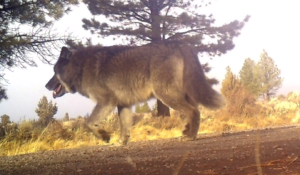
Remote camera photo taken in western Lake County of an adult wolf using the same area as OR-28 (photo by ODFW, Dec. 2015).
December 23, 2015: OR-31, a yearling of the Mt. Emily Pack, is shot by a poacher near the boundary of the Umatilla Indian Reservation.
December 2015: A legal challenge has been filed by Cascadia Wildlands, Center for Biological Diversity and Oregon Wild to contest the removal of state endangered species protections for gray wolves by the ODFW Commission in November. The suit states that the decision was not based on verifiable, best available science and that Oregon’s wolves are not recovered and thus, it is too soon to remove protections.
December 2015: OR-28 has been detected in Lake County. She spent time in Klamath County last month. Another wolf is in the same area as OR-28, a two-year old female from the Mt. Emily Pack in Umatilla County, as documented by this ODFW trail camera (see image above, right).
November 20, 2015: ODFW updates their list of non-lethal measures to minimize wolf-livestock conflict.
November 10, 2015: The ODFW Commission votes 4-2 to remove endangered species protections for Oregon’s wolves. Commissioners Greg Wolley and Laura Anderson are the only ones to vote against the delisting. Over 90% of public comments submitted were overwhelmingly in favor of maintaining protections. More than twenty wildlife scientists submitted extensive testimony; all stating that removing protections would be premature.
October 29, 2015: Scientists slam Oregon’s ‘fundamentally flawed’ proposal to strip wolves of state endangered species protections.
October 28, 2015: OR-7’s radio collar is no longer functioning.
October 9, 2015: Thousands of people submit written testimony, many show up in person to testify and more than twenty scientists submit detailed testimony at the ODFW Commission hearing to express their outrage at the possible delisting of wolves from the state endangered species list.
October 2015: Scat analysis reveals that the alpha female of the Shasta Pack in northern California dispersed from the Imnaha Pack.
October 2015: OR-22 was shot by a hunter who believed the radio-collared animal with ear tags was a coyote. The hunter turned himself in and was later fined, ordered to pay restitution and forfeit his rifle to the state.
October 2015: OR-3, one of the brothers of OR-7 who dispersed from the Imnaha Pack in May 2011, has been documented in Central Oregon. He had not been seen since his dispersal.
September 2015: OR-34, a female from the Walla Walla Pack, is shot by a poacher.
August 2015: California is home to its first wolf pack in over 90 years! Named the Shasta Pack, they are comprised of two adults and five pups. These wolves dispersed from Oregon and are living proof that wolves are returning to their historic ranges.
August 2015: OR-25 is now in Klamath County. He dispersed from the Imnaha Pack in March this year. He is covering a lot of ground, as is common for dispersing wolves.
July 2015: A trail camera/video from USFWF and ODFW show the yearling pups of the Rogue Pack playing. This brings the Rogue Pack to at least seven wolves, including five pups, OR-7 and his mate.
May 2015: Cascadia Wildlands and Western Environmental Law Center file a Freedom of Information Act request to see all Forest Service plans for protecting wolves while selling off timber and building roads in Oregon and Washington’s national forests.
April, 2015: OR- 25, a two-year old male, who dispersed from the Imnaha Pack last month is documented in southern Washington and then on the Warm Springs Indian Reservation.
February 2015: Annual 2014 ODFW Wolf Report released this month shows 77 known wolves in the state comprised of nine packs, five pairs traveling together, and two individual wolves. There are eight documented breeding pairs that had 26 known pups that survived through the end of 2014. A copy of the ODFW report can be viewed here.
January 28, 2015: ODFW announces it is moving into Phase II of the Wolf Management Plan in the eastern portion of Oregon when state wildlife biologists confirm there are seven breeding pairs in Oregon in 2014. This means livestock producers have more management flexibility in dealing with wolf-livestock conflict.
January 2015: OR-7, his mate and almost yearling pups, three of whom survived the winter, have now been named the Rogue Pack.
2014
December 2014: Wolves continue to be federally protected west of Oregon highways 395/78/95. Wolves east of this designated federal protection area are still protected under Oregon’s state Endangered Species Act. The state Wolf Plan sets a conservation population objective of four breeding pairs for three consecutive years in eastern Oregon. This is the first year this objective has been reached and thus entry into Phase 2 of the Wolf Plan begins. To review the Oregon Wolf Conservation and Management Plan, click here.
By end of the year, nine packs are documented, eight in NE Oregon and one in SW Oregon) and includes two recently formed packs, the Meacham and Rogue Packs. Six new pairs of wolves were documented this year with a minimum total population estimated to be 77 wolves.
September 2014: Genetic testing on scat samples reveal that OR-7’s mate likely comes from either the Snake River or Minam Pack.
July 2014: It has been confirmed that OR-7 not only has a mate, but they have had their first litter of pups! The images via trail camera show OR-7, his mate and two pups. They are the first known wolves breeding in the Oregon Cascades in almost a century.
May 14, 2014: CBC Radio interview with John Stephenson, ODFW wolf biologist about OR-7, his mate and probable pups.
May 2014: This marks the third year in a row that ODFW has not killed any wolves for livestock depredation.
May 2014: After traveling thousands of miles since his dispersal from the Imnaha Pack in December 2011, making his way into California and back up into Oregon, it appears that OR-7 may have found a mate. Trail cameras reveal a second wolf in the area where OR-7 is living. It was confirmed that she is female when the camera caught her squatting to pee.
February 2014: The Wolf Conservation and Management Report is released by ODFW. Annual report for 2013 shows 64 known wolves in the state comprised of eight packs, four of whom include breeding pairs, and including two new packs (Mt. Emily and an unnamed pack in the Catherine Creek/Keating WMU). All packs are located in the far NE corner of the state. A copy of the 2013 ODFW report can be viewed here.
2013
December 31, 2013: At the end of year, ODFW determines that there are seven packs, of which four are breeding pairs, plus three individual wolves, accounting for an approximate increase of 15 wolves in the overall population in the state.
December 2013: Based on information from his radio collar, OR-7 took a day trip into northern California and then returned to Oregon.
August 30, 2013: Conflict Deterrence Plan released for the Umatilla River Pack. Under new wolf management rules, ODFW and livestock producers are required to develop and publicly disclose Conflict Deterrence Plans in Areas of Depredating Wolves.
July 30, 2013: There are two documented pups for the Mt. Emily Pack. As of today, there are pups confirmed in the Imnaha, Minam, Mt. Emily, Snake River, Umatilla River, Walla Walla and Wenaha Packs!
July 2013: ODFW officially passes the new administrative rules that amend the management of wolves in Oregon.
May 30, 2013: It is determined that the cause of death of OR-19 is complications related to canine parvovirus. This disease is common amongst domestic dogs, but can also affect coyotes, foxes and wolves. It is the first documented case of parvovirus in Oregon wolves.
May 28, 2013: In relation to the court-ordered stay issued by the Oregon Court of Appeals in October 2011, administrative rule changes in the Oregon Wolf Conservation and Management Plan have been agreed upon. During 2012, all parties (ODFW, Oregon Cattlemen’s Association, Cascadia Wildlands, Oregon Wild, and the Center for Biological Diversity) were in negotiations on changes to rules in regards to lethal control of wolves.
The rule changes included agreement on the following (CBD withdrew from negotiations in fall of 2012):
(1) Before ODFW can employ lethal controls, it must confirm four qualifying incidents within a six-month period.
(2) Requires the development and public disclosure of wolf-livestock conflict deterrence plans that can be implemented by livestock producers.
(3) Requires that these non-lethal measures be implemented prior to a depredation in order for the depredation incident to qualify for lethal control.
(4) Adds a rule that any ODFW lethal control decision lasts for a 45 day period.
Rules changes in their entirety can be read here.
May 19, 2013: OR-19, a female from the Wenaha Pack who had been collared six days previously, is found dead of unknown cause.
March 2013: OR-7 returns to Oregon from California and is seen in Jackson County.
February 2013: Annual ODFW Wolf Report for 2012 released this month shows 46 known wolves in the state comprised of one non-breeding pair, two individuals and six packs that produced at least 22 pups that survived through the end of 2012. All packs are living in the far NE corner of the state. A copy of the 2012 ODFW report can be viewed here.
2012
December 31, 2012: The court-ordered stay issued by the Oregon Court of Appeals on Oct. 2, 2011 preventing the lethal removal of depredating wolves remains in effect pending resolution of litigation filed by Cascadia Wildlands and allies challenging the Commission’s authority to authorize the killing of listed wolves under the Commission’s “chronic depredation” take rules.
December 21, 2012: Coinciding with the year anniversary of OR-7 setting paw in California, the Pacific Wolf Coalition is formed. Comprised of twenty-five wildlife conservation, education and protection organizations in California, Oregon and Washington, they are committed to envisioning populations of wolves restored over their historic habitats in numbers that allow them to re-establish their critical role in nature and ensure their long-term survival.
December 19, 2012: OR-16, a 1½ year old wolf from the Walla Walla Pack crossed into Idaho. He was shot by a poacher in Idaho less than a month later.
December 2012: OR-7 spent much of this year in California, becoming the first documented wolf in that state in 90 years.
November 2012: DNA analysis of scat confirms that OR-12 is the breeding male of the Wenaha Pack. He dispersed from the Imnaha Pack and is the first wolf born into a pack in Oregon who dispersed and successfully bred with another pack in Oregon.
September 2012: ODFW confirmed pups for the Walla Walla Pack documenting two black pups traveling with the pack. OR-10 and OR-11 are also traveling with this pack bringing the pack number to 10 wolves (8 adults, 2 pups).
August 31, 2102: A new wolf pack, including a pair of adults and five gray pups, have been observed in the Upper Minam River drainage area.
August 2012: A survey on US Forest Service land southeast of Joseph revealed at least six pups for the Imnaha Pack this year.
In addition, the Wenaha Pack now have seven documented pups. The Umatilla Pair have at least two pups, which makes them an official pack now.
July 2012: The Snake River Pack has at least three adults and three pups. Here is video footage of the pup howling and the pack returning the howl. This is a major way in which the packs communicate with each other.
June 2012: There are four pups observed for the Imnaha Pack for this year. Biologists also confirm at least four pups in the Wenaha Pack (see image above, right).
May 4, 2012: As of today, based on state government data, 254 wolves have been shot and 124 have been trapped in Idaho this hunting season. In Montana, 166 wolves have been killed this season.
May 2, 2012: The wolf found dead in early March near Cove, Oregon in Union County is confirmed to be a poaching by Oregon State Police and ODFW. The investigation of the crime continues. Genetic testing showed the wolf was from the Imnaha Pack.
April 17, 2012: OR-7 returns to California.
March 14, 2012: 9th Circuit Court of Appeals upholds the district court ruling and allows the delisting of gray wolves in the Rocky Mountain states of Montana and Idaho (wolves are still listed in Wyoming due to the state’s egregious management plan). Gray wolf hunting resumes.
March 7, 2012: Bill to overturn the ban on killing Oregon’s endangered gray wolves is defeated in Salem. Cascadia Wildlands and allies spent considerable time in Salem educating policy makers and testifying against this the reckless legislation.
March 1, 2012: OR-7 crosses back over into Oregon and is spending time in Klamath and Douglas counties.
February 2, 2012: Oregon Cattlemen’s Association brings a bill to the state legislature to overturn the recently issued injunction that prohibits killing Oregon’s endangered gray wolves.
2011
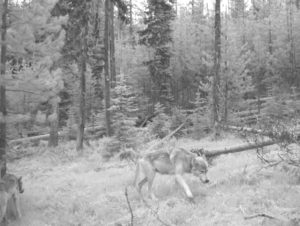
From left, a two-year-old male and the alpha female of the Imnaha pack. Image captured on trail camera in Wallowa Whitman National Forest, Wallowa County (photo by ODFW, June 2011).
December 30, 2011: OR-7, or Journey, makes his way into California from Oregon, becoming the first wolf to return to the state in nearly 80 years.
December 28, 2011: Oregon’s four known wolf packs, the Imnaha, Wenaha, Walla Walla and Snake River packs, all had pups this past year. Oregon currently has approximately 29 confirmed wolves in the state according to the Oregon Department of Fish and Wildlife. A copy of the entire ODFW 2011 Wolf Report can be viewed here.
December 12, 2011: Dispersing Imnaha Pack wolf, known as OR-7 (Journey), travels 730 miles to southwest Oregon searching for mate and territory.
November 14, 2011: Oregon Court of Appeals extends ban on killing endangered Oregon wolves.
November 1, 2011: OR-7, who dispersed from the Imnaha Pack in September is located in the Umpqua National Forest. This marks the first confirmed wolf in the Oregon Cascades in over 60 years.
October 5, 2011: Oregon Court of Appeals grants emergency stay of execution of two Imnaha Pack wolves.
October 5, 2011: Cascadia Wildlands and allies file a legal challenge in state court to immediately halt the state killing of two of the remaining four Imnaha Pack wolves. A memo on our lawsuit is sent to Governor Kitzhaber and key legislators.
September 26, 2011: At least two pups documented in the Walla Walla Pack by ODFW.
September 23, 2011: Oregon Department of Fish and Wildlife issues a kill order for the alpha male (pack leader) and a yearling in the Imnaha Pack after a confirmed livestock depredation near Joseph, OR, deeming the situation as “chronic.”
June 6, 2011: Cascadia Wildlands and allies send a letter to Oregon Department of Fish and Wildlife about the recent lethal control of two Imnaha Pack wolves, kill order for up to two more wolves, and the issuance of 24 “caught in the act” kill permits to private landowners.
May 18, 2011: Oregon Department of Fish and Wildlife kills second Imnaha Pack wolf in the past three days after attributing recent livestock depredations in Wallowa County to the pack.
May 3, 2011: Cascadia Wildlands and allies file a legal challenge against US Fish and Wildlife Service’s order to kill two Imnaha pack wolves. The kill order is issued after the death of a calf on May 1st in Wallowa County is confirmed as a wolf kill.
April 14, 2011: Congress legislatively delists gray wolves in the northern Rockies from the Endangered Species Act as part of a rider attached to the federal budget bill. In addition to removing federal protections in Montana and Idaho, the unprecedented action also strips protections for wolves in eastern Oregon, eastern Washington and northern Utah. The delisting will likely mean sport hunting for wolves in Montana and Idaho this fall.
March 30, 2011: Cascadia Wildlands presents testimony in the House Agriculture and Natural Resources Committee in the Oregon Legislature on a number of bills affecting Oregon’s recovering gray wolf population.
March 18, 2011: Cascadia Wildlands and eight co-plaintiffs settle our legal challenge to the Obama administration’s Northern Rocky Mountains gray wolf delisting from the Endangered Species Act.
March 1, 2011: Cascadia Wildlands delivers a memo to all 90 Oregon legislators describing anti-wolf bills that have been introduced into the 76th session in Salem.
March 1, 2011: Yearling female from Oregon’s Imnaha pack is found dead. The cause of the death of the collared wolf is unclear.
2010
December 2010: Idaho and Montana senators propose to legislate delisting of gray wolves in the Rockies.
October 8, 2010: Conservation groups offer $7,500 reward for information leading to the prosecution of the person/s responsible for killing an endangered gray wolf from the Wenaha Pack in eastern Oregon.
August 5, 2010: Federal district court judge Donald Malloy in Missoula rules in favor of Cascadia Wildlands’ lawsuit challenging the government’s delisting of the gray wolf from the Endangered Species Act in the northern Rocky Mountains. Cascadia was one of 13 co-plaintiffs and was represented by Earthjustice in the case.
July 8, 2010: Cascadia Wildlands and allies file a lawsuit and halt the hunt of members of Oregon’s Imnaha wolf pack.
2009
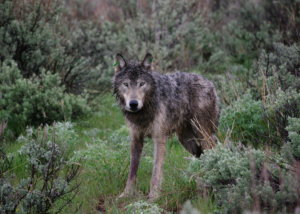
Oregon’s first radio-collared wolf, an 87-pound male estimated to be about 2-years-old, just after its release, with ear tags and a radio collar (photo by ODFW, May 2009).
Fall-Winter 2009: Over 250 gray wolves are killed in Montana and Idaho during sport hunts after wolves are delisted by the Obama administration.
September 8, 2009: Federal district court judge Donald Malloy in Missoula rules against Cascadia Wildlands’ request for a Preliminary Injunction but suggested in his ruling that we are likely to succeed on the merits of the lawsuit. The lawsuit will likely be heard in early 2010.
September 5, 2009: Two wolves in Baker County’s Keating Valley are killed after repeated depredations of livestock. The two wolves, which are apparently not part of an organized pack, represent approximately 20% of the known wolves in Oregon today.
June 2, 2009: Cascadia Wildlands and 12 conservation partners represented by Earthjustice legally challenge the removal of Endangered Species Act protections for gray wolves in Idaho, Montana, and eastern Oregon and Washington.
April 2, 2009: The Obama administration’s US Fish and Wildlife Service removes gray wolves from the Endangered Species Act, finalizing an effort initiated by the Bush administration. Idaho and Montana begin to plan a wolf hunting season.
2008
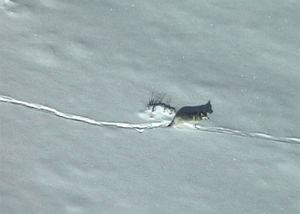
Aerial footage of wolf B-300 in northeastern Oregon. B-300 was the first wolf confirmed to have returned to Oregon from Idaho since 2000 (photo by ODFW, Jan. 2008).
July 18, 2008: Federal District Court Judge Donald Malloy issues a preliminary injunction halting the gray wolf delisting in the Northern Rocky Mountains. This is not a ruling on the merits of the case, rather a placeholder while attorneys argue the claims.
April 28, 2008: Following up on its February 27 notice of intent to sue, Cascadia Wildlands and 11 co-plaintiffs file a lawsuit and preliminary injunction request to halt killing of gray wolves in Idaho, Montana and Wyoming. Since the delisting occurred in March, dozens of wolves have been killed by sport hunters.
February 27, 2008: Represented by Earthjustice, Cascadia Wildlands and 11 co-plaintiffs file a 60-day notice of intent to sue the US Fish and Wildlife Service over the removal of the Northern Rocky Mountains population of the gray wolf from the Endangered Species Act. The delisting will turn over management of the species to states in the inter-mountain West. Montana, Idaho and Wyoming all have management plans in place that would permit rampant killing of wolves.

